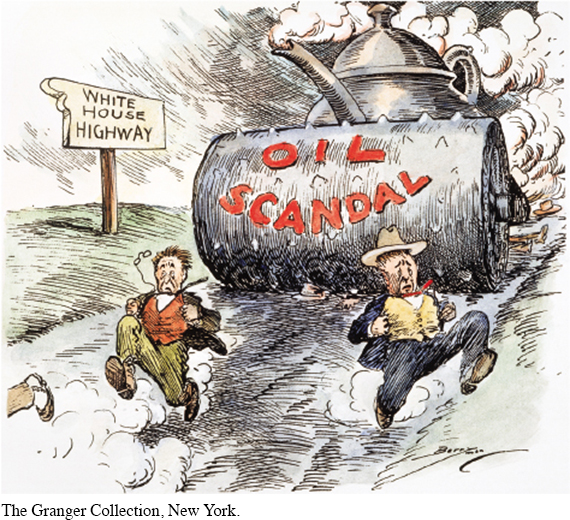A Business Government
Republicans controlled the White House from 1921 to 1933. The first of the three Republican presidents was Warren Gamaliel Harding, the Ohio senator who in his 1920 campaign called for a “return to normalcy,” by which he meant the end of public crusades and a return to private pursuits. Harding appointed a few men of real stature to his cabinet. Herbert Hoover, for example, the former head of the wartime Food Administration, became secretary of commerce. But wealth and friendship also counted: Andrew Mellon, one of the richest men in America, became secretary of the treasury, and Harding handed out jobs to his friends, members of his old “Ohio gang.” This curious combination of merit and cronyism made for a disjointed administration.
When Harding was elected in 1920 (see chapter 22, Map 22.6), the unemployment rate hit 20 percent, the highest ever up to that point. The bankruptcy rate of farmers increased tenfold. Harding pushed measures to regain national prosperity—high tariffs to protect American businesses, price supports for agriculture, and the dismantling of wartime government control over industry in favor of unregulated private business. “Never before, here or anywhere else,” the U.S. Chamber of Commerce said proudly, “has a government been so completely fused with business.”
Harding’s policies to boost American enterprise made him very popular, but ultimately his small-town congeniality and trusting ways did him in. Some of his friends in the Ohio gang were up to their necks in lawbreaking. Three of Harding’s appointees would go to jail. Interior Secretary Albert Fall was convicted of accepting bribes of more than $400,000 for leasing oil reserves on public land in Teapot Dome, Wyoming, and “Teapot Dome” became a synonym for political corruption. [[LP Photo: P23.02 “Teapot Dome Scandal, 1924”/

On August 2, 1923, when Harding died from a heart attack, Vice President Calvin Coolidge became president. Coolidge, who once said that “the man who builds a factory builds a temple, the man who works there worships there,” continued and extended Harding’s policies of promoting business and limiting government. Secretary of the Treasury Andrew Mellon reduced the government’s control over the economy and cut taxes for corporations and wealthy individuals. New rules for the Federal Trade Commission severely restricted its power to regulate business. Secretary of Commerce Herbert Hoover hedged government authority by encouraging trade associations that ideally would keep business honest and efficient through voluntary cooperation.
Coolidge found an ally in the Supreme Court. For years, the Court had opposed federal regulation of hours, wages, and working conditions on the grounds that such legislation was the proper concern of the states. In the 1920s, the Court found ways to curtail a state’s ability to regulate business. It ruled against closed shops—businesses where only union members could be employed—while confirming the right of owners to form exclusive trade associations. In 1923, the Court declared unconstitutional the District of Columbia’s minimum-wage law for women, asserting that the law interfered with the freedom of employer and employee to make labor contracts. The Court and the president attacked government intrusion in the free market, even when the prohibition of government regulation threatened the welfare of workers.
> TRACE CHANGE
OVER TIME
How was the federal government’s relationship to the economy in the 1920s different from that of the 1900s and 1910s?
The election of 1924 confirmed the defeat of the progressive principle that the state should take a leading role in ensuring the general welfare. To oppose Coolidge, the Democrats nominated John W. Davis, a corporate lawyer whose conservative views differed little from Republican principles. Only the Progressive Party and its presidential nominee, Senator Robert La Follette of Wisconsin, offered a genuine alternative. When La Follette championed labor unions, regulation of business, and protection of civil liberties, Republicans coined the slogan “Coolidge or Chaos.” Voters chose Coolidge in a landslide. Coolidge was right when he declared, “This is a business country, and it wants a business government.” What was true of the government’s relationship to business at home was also true abroad.
Understanding the American Promise 3ePrinted Page 649
Section Chronology